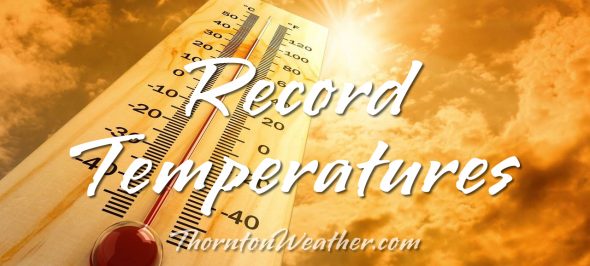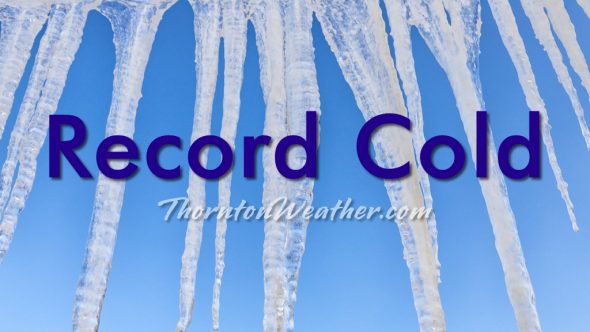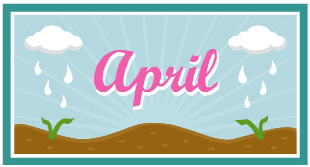
As we pointed out in our April weather preview, the month can bring just about any type of weather condition and we see that in our look back at this week in Denver weather history. From powerful, damaging winds to Arctic cold to heavy snowfall this has been an eventful week in the past.
From the National Weather Service:
31-2
In 1980…the second major blizzard in 5 days buried much of eastern Colorado under 6 to 12 inches of snow. Some drifts were up to 22 feet high. Hundreds of travelers were stranded. Over 3000 families were without power. Livestock losses were high. Metro Denver escaped the main brunt of this storm. At Stapleton International Airport…only 6.3 inches of snow fell over the 3-day period and north winds gusted to only 22 mph on the 1st.
31-3
In 1979…total snowfall of 6.6 inches was measured at Stapleton International Airport where north winds gusted to 31 mph on the 31st. The greatest accumulation of snow on the ground was 3 inches on the 1st.
31-4
In 1905…much rain and some snow occurred over the 5 days behind an apparent cold front. Precipitation totaled 2.00 inches. There was a thunderstorm on the 3rd. Snowfall totaled 3.0 inches on the 4th. North winds were sustained to 34 mph on the 1st and 2nd and to 30 mph on the 3rd. High temperatures during the period ranged from the upper 30’s to the lower 40’s. Low temperatures were in the upper 20’s and lower 30’s.
1
In 1987…a vigorous cold front produced 2.3 inches of snowfall at Stapleton International Airport where northeast winds gusted to 39 mph. The temperature dropped from a maximum of 59 degrees at mid-morning to a low of 25 degrees at midnight.
1-2
In 1963…strong winds buffeted metro Denver…while wind- whipped fires consumed grassland on the plains. A child was injured by a windblown falling tree in Castle Rock. Southwest winds gusted to 52 mph at Stapleton Airport… Causing some blowing dust. The worst fire storm burned over 25 thousand acres of grazing land in southern Weld County near Roggen northeast of Denver.
In 1984…a snowstorm with near-blizzard conditions over eastern Colorado closed many roads…including I-70 and I-76 east of Denver and I-25 between Denver and Colorado springs. At Stapleton International Airport…snowfall totaled only 2.5 inches…but north winds gusted to 45 mph on the 2nd.
In 1999…moist upslope conditions allowed heavy snow to develop in the Front Range foothills where snowfall totals included: 10 inches at Aspen Park and Evergreen; 9 inches at Turkey Creek; 8 inches at Idaho Springs and Genesee; 7 inches at Aspen Springs…Crow Hill…Intercanyon…and Lake George. In metro Denver snowfall totals included: 10 inches south of Sedalia; 8 inches in Littleton; 7 inches at Morrison; 6 inches at Highlands Ranch; and 4 to 5 inches in Northglenn…Parker and near Louisville. Snowfall totaled 4.7 inches at the site of the former Stapleton International Airport.
1-3
In 1945…snow fell across metro Denver for a total of 51 consecutive hours. While the storm was not accompanied by excessive snow…the long duration made the event a heavy snow producer. Snowfall totaled 10.7 inches in downtown Denver with 9.5 inches recorded at Stapleton Airport. North winds were sustained to 21 mph on the 1st; otherwise winds were not strong. The air mass was very cold for April. The high temperatures of 26 on the 2nd and 17 on the 3rd were record low maximums for the dates. The latter was also a record low maximum for the month. Warm weather following the storm quickly melted the snow.
In 1973…heavy snow fell at Stapleton International Airport where 8.7 inches were measured. Snow began late on the 1st and continued through early morning on the 3rd. Thunder accompanied the snow during the late morning and afternoon of the 2nd. North winds gusted to 33 mph on the 2nd and 37 mph on the 3rd. Snow only accumulated to a depth of 5 inches on the ground due to melting.
In 1977 a foot of snow fell in Boulder and Broomfield. The Denver-Boulder turnpike was closed for an hour after numerous minor traffic accidents. At Stapleton International Airport…snowfall totaled 4.7 inches and southeast winds gusted to 32 mph on the 2nd. The greatest depth of snow on the ground was only 3 inches due to melting.
2
In 1894…northwest winds were sustained to 42 mph with gusts to 48 mph. The warm Chinook winds warmed the temperature to a high of 70 degrees.
In 1925…north winds were sustained to 40 mph with gusts to 42 mph.
In 1957…a heavy snow storm dumped 17.3 inches of snow at Stapleton Airport. Strong gusty north winds to 31 mph reduced visibilities to 1/8 mile at times and created blizzard conditions. The 24-hour snowfall had been exceeded only twice in previous records…and the 24 hour precipitation of 2.05 inches was the third heaviest of previous record during April.
In 1959…a cold front produced strong gusty winds across metro Denver. North winds gusting to 50 and 60 mph caused some minor damage to power lines and signs and caused dust storms on the plains east of Denver. A wind gust to 49 mph was recorded at Stapleton Airport.
In 1966…northwest winds gusting to 52 mph produced blowing dust…which briefly reduced the visibility to 1 mile at Stapleton International Airport.
In 1975…the all-time lowest recorded temperature in April… 2 degrees below zero…occurred. This is also the latest below zero reading for the season.
In 1982…a strong windstorm struck all of metro Denver… Causing minor damage. Wind gusts to 127 mph were recorded at Rocky Flats south of Boulder…116 mph at Wondervu…100 mph at Jefferson County Airport in Broomfield…and 56 mph at Stapleton International Airport. The strong winds whipped up blowing dust…briefly reducing the visibility to 3/4 mile.
In 1986…heavy thunderstorms produced wind gusts to about 70 mph in Boulder. A severe thunderstorm wind gust to 62 mph was recorded at Stapleton International Airport. The strong winds kicked up thick clouds of blowing dust severely restricting surface visibility.
In 1997…a pacific storm left heavy snow in the foothills with lesser amounts across the city. Snowfall totaled 12 inches near Blackhawk…11 inches at Golden Gate Canyon…10 inches at Conifer and Crow Hill…9 inches at Evergreen…5 inches at Sedalia…and 4 inches at Castle Rock and Morrison. Only 2.1 inches of snow fell at the site of the former Stapleton International Airport. Northwest winds gusted to 21 mph at Denver International Airport.
In 1998…a major spring storm brought heavy snow to metro Denver and the foothills. Snowfall totals ranged from 12 to 22 inches in the foothills with 4 to 12 inches across metro Denver. Snowfall totals included: 22.5 inches near conifer; 13 inches in Coal Creek Canyon; 12 inches near Blackhawk…Eldora…and Genesee; 10 inches near Evergreen and Nederland; 9 inches in Lakewood; 8 inches in Broomfield and northwest Denver; and 7.0 inches at the site of the former Stapleton International Airport. Northeast winds gusted to 31 mph at Denver International Airport.
In 2002…snowfall was only a trace at the site of the former Stapleton International Airport. This was the only snowfall of the month…ranking the month…along with previous months… The 2nd least snowiest on record.
2-3
In 1955…strong west to southwest winds raked metro Denver on both days. Sustained winds as high as 37 mph with gusts to 60 mph were recorded at Stapleton Airport where the visibility was reduced to 1/4 mile in blowing dust.
In 1974…a heavy snowfall of 6.7 inches was accompanied by northeast wind gusts to 33 mph which produced some blowing snow across metro Denver. Over eastern Colorado many highways and schools were closed due to near-blizzard conditions from the storm.
In 1986…the worst snow storm of the season blasted metro Denver. Heavy snow and high winds combined to close roads… Schools…and airports. Portions of all interstate highways out of Denver were closed at times. The snow came after an exceptionally mild late winter and early spring; trees and bushes had already bloomed and leafed out. The snow and wind snapped many of these…causing power outages. Total snowfall amounts in metro Denver ranged from 1 to 2 feet with 2 to 3 feet in the foothills. Snowfall totaled 12.6 inches at Stapleton International Airport where north winds gusting to 39 mph reduced the visibility to 1/8 mile in snow and blowing snow. Most of the snow fell on the 3rd when temperatures hovered around 30 degrees for most of the day. The heavy snow halted traffic and closed businesses. A 59- year-old man was found dead from exposure in northwest Denver. The roof of a toy store in Northglenn collapsed. A 100 thousand square foot section of a greenhouse roof collapsed in Golden…destroying over a million dollars worth of plants.
In 2000…a combination of strong instability and moist upslope winds allowed for a heavy…wet spring snowstorm to develop in and near the Front Range foothills. The heaviest snow occurred in southern Jefferson County. Storm totals included: 14 inches near Conifer…12 inches near Evergreen and on Floyd Hill; 11 inches near Blackhawk…Morrison…and tiny town; 10 inches at Aspen Springs and Eldora Ski Area; 9 inches at Chief Hosa; and 8 inches at both Golden Gate Canyon and Rollinsville. Only 2.1 inches of snow fell at the site of the former Stapleton International Airport. North winds gusted to 36 mph at Denver International Airport on the 2nd.
In 2014…a storm system brought moderate to heavy snow to the Front Range Mountains…Foothills and Urban Corridor. Storm totals in the mountains and foothills included: 21.5 inches…8 miles north of Blackhawk; 15.5 inches near Rollinsville; 15 inches at Aspen Springs; 14.5 inches near Ward; 12 inches…6 miles southwest of Evergreen; 11 inches at Cabin Creek and 12 miles south-southwest of Georgetown; 10 inches at Winter Park; 8 inches near Conifer…Georgetown and Gross Reservoir; with 7.5 inches at Bailey and Intercanyon. In the Urban Corridor…storm totals included: 9.5 inches near Highlands Ranch…7 inches at Boulder… 6 inches near Castle Rock…with 5.5 inches at Lakewood and near Morrison. At Denver International Airport…3.4 inches of snowfall was observed.
2-4
In 1934…snowfall totaled 8.2 inches in downtown Denver from the afternoon of the 2nd through the early morning of the 4th. Most of the snow…6.8 inches…fell on the 3rd. Rain changed to snow behind a strong cold front on the afternoon of the 2nd. The cold front first appeared as a long-cigar shaped squall cloud to the north of the city. Strong north winds at sustained speeds of 33 mph with gusts to 43 mph produced much blowing dust and an abrupt fall in temperature…from a high of 68 on the 2nd to a low of 22 on the 3rd.
In 1964…a major storm dumped 10.9 inches of heavy wet snow on Stapleton International Airport where northeast winds gusted to 35 mph. Most of the snow…10.0 inches…fell on the 3rd.
2-5
In 1918…snowfall totaled 12.4 inches over downtown Denver. Most of the snow fell on the 3rd and 4th. Temperatures were in the 20’s and 30’s. Northwest winds were sustained to 24 mph on the 2nd. Continue reading April 2 to April 8: This week in Denver weather history →






